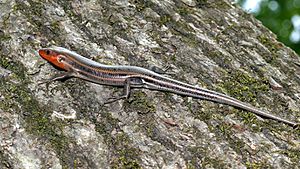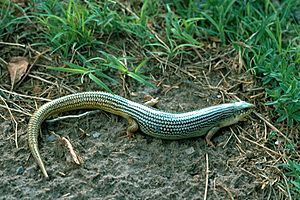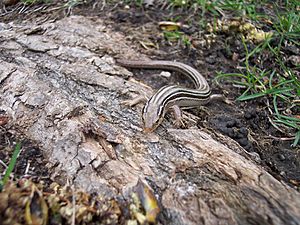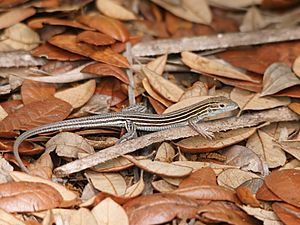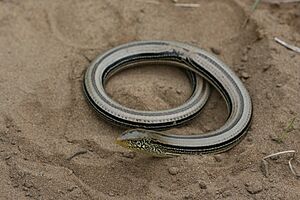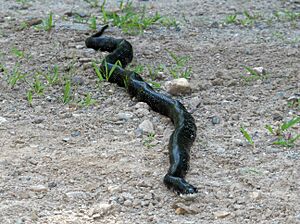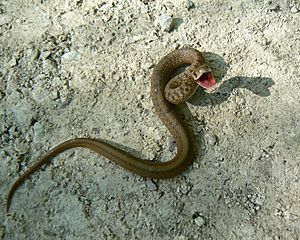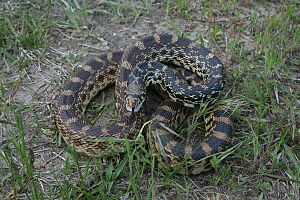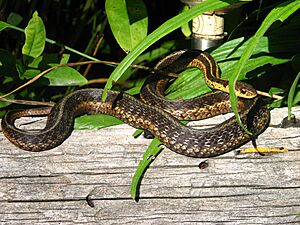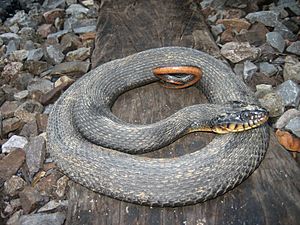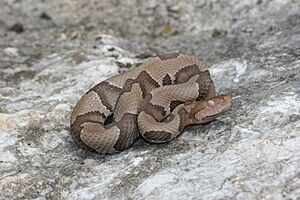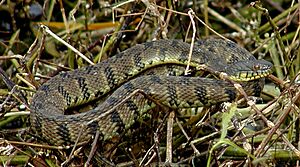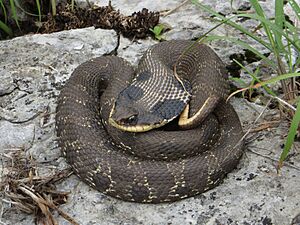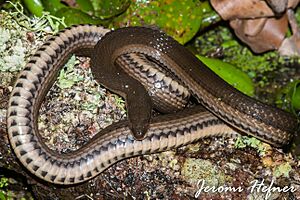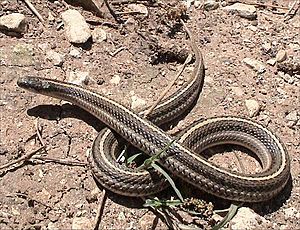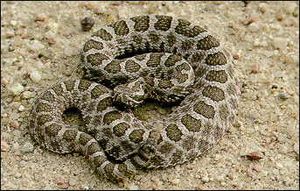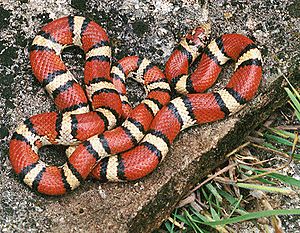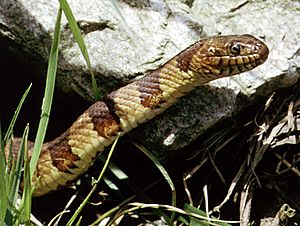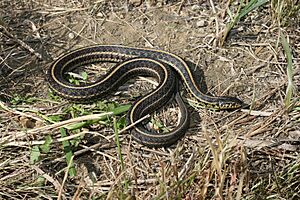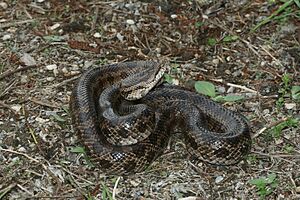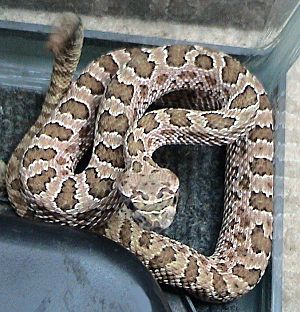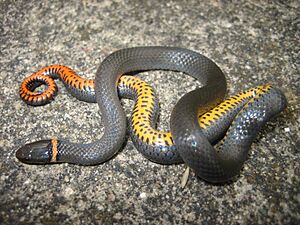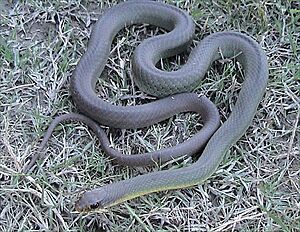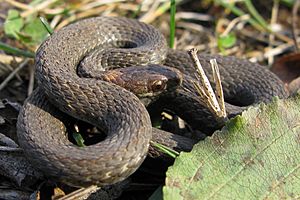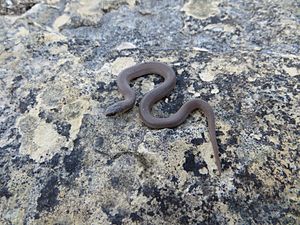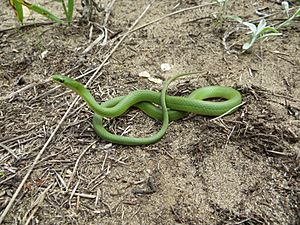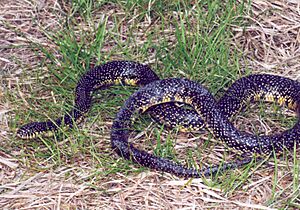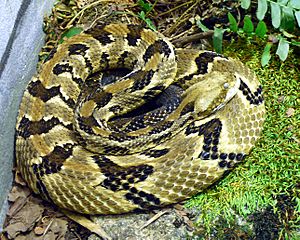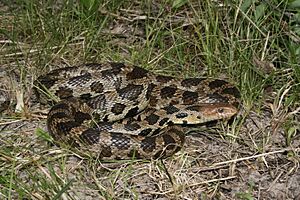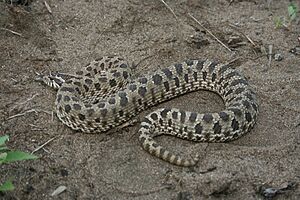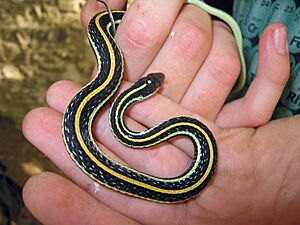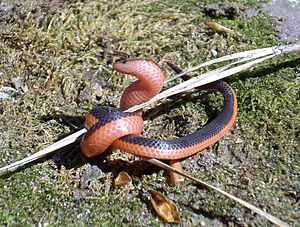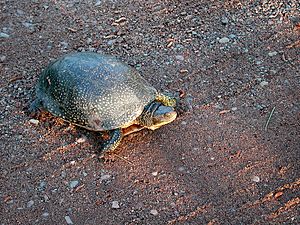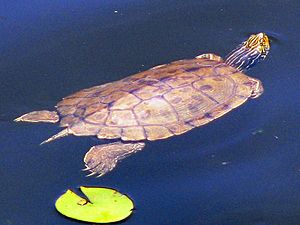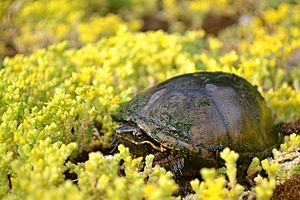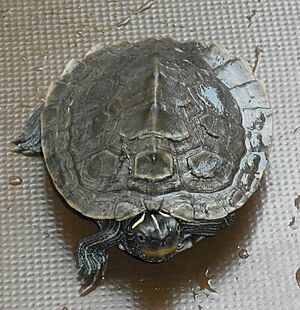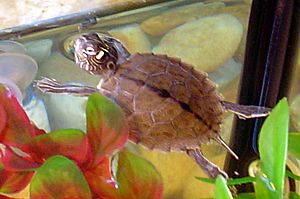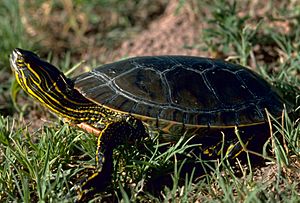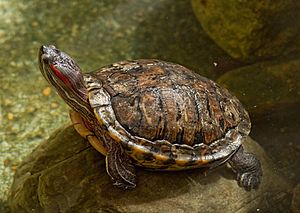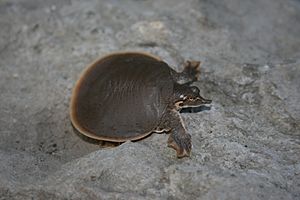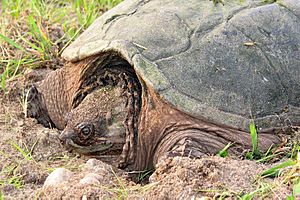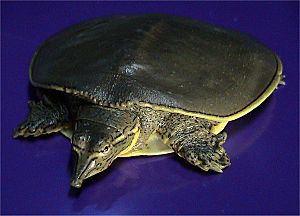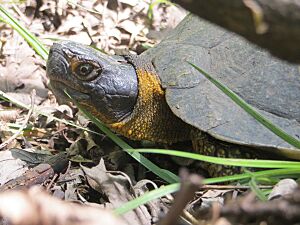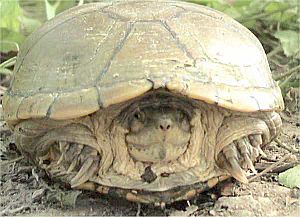List of reptiles of Iowa facts for kids
The state of Iowa is home to many amazing animals, including different kinds of reptiles! This list will tell you about all the snakes, turtles, and lizards that live in Iowa. Some of these reptiles are very common, while others are quite rare and need our help to survive.
Contents
Lizards of Iowa
Iowa has five different types of lizards. Lizards are often shy and can be hard to spot in the wild. They are usually found in sunny, open areas.
Young five-lined skinks have bright blue tails. This helps to distract predators. As they get older, their tails turn gray.
This skink is considered Endangered in Iowa. This means there are very few of them left. They need special protection to keep their populations from disappearing.
Prairie skinks are small and live in grassy areas. They are good at hiding from predators.
These lizards are very fast! They have six light stripes down their backs. They love hot, sandy places.
The slender glass lizard is Threatened in Iowa. It looks like a snake but is actually a lizard without legs. It can even drop its tail if it feels threatened, just like other lizards!
Snakes of Iowa
There are 27 different kinds of snakes living in Iowa. Most snakes in Iowa are harmless and play an important role in the ecosystem. However, a few are venomous and should be observed from a safe distance.
- Black rat snake (Pantherophis obsoletus)
These are Iowa's longest snakes. They are excellent climbers and often hunt for birds and rodents in trees.
- Brown snake (Storeria dekayi)
Brown snakes are small and secretive. They often hide under rocks or logs. They mostly eat slugs and worms.
Bullsnakes are large and can hiss loudly when scared. They are not venomous and help control rodent populations. They are a species of Special Concern in Iowa.
Garter snakes are one of the most common snakes in Iowa. You might see them in your backyard!
This water snake is Endangered in Iowa. It lives near water and has a reddish-orange belly.
The copperhead is a venomous snake and is Endangered in Iowa. It has a distinctive copper-colored head and hourglass-shaped markings. Always give venomous snakes plenty of space.
This water snake is Threatened in Iowa. It has a pattern that looks like diamonds on its back.
Hognose snakes are known for playing dead when they feel threatened. They will flip over and stick out their tongue!
These snakes love to eat crayfish and live near water.
Lined snakes are small and have light stripes down their backs. They are often found in urban areas.
This venomous rattlesnake is Endangered in Iowa. It is a smaller rattlesnake, but still dangerous. Its rattle makes a buzzing sound.
Milk snakes have colorful bands of red, black, and white or yellow. They are harmless and often mistaken for venomous coral snakes (which do not live in Iowa).
These non-venomous snakes are often seen near ponds and rivers. They are good swimmers and eat fish and amphibians.
Similar to the common garter snake, but often found in drier, open grasslands.
Kingsnakes are known for eating other snakes, even venomous ones! They are harmless to humans.
This venomous rattlesnake is Endangered in Iowa. It lives in prairie habitats and uses its rattle to warn off threats.
- Prairie ringneck snake (Diadophis punctatus arnyi)
These small snakes have a distinct yellow or orange ring around their neck. They are harmless.
Racers are very fast and active snakes. They are usually solid colored, often blue-gray or black.
A tiny snake with a bright red or orange belly. They are harmless and eat slugs and worms.
These small, brown snakes are very secretive and live underground or under leaf litter.
This beautiful bright green snake is a species of Special Concern in Iowa. It eats insects like crickets and caterpillars.
- Speckled kingsnake (Lampropeltis getula holbrooki)
This kingsnake is Threatened in Iowa. It has a dark body with yellow speckles.
The timber rattlesnake is a large, venomous snake found in forested areas. It has a loud rattle. Always keep a safe distance from any rattlesnake.
Fox snakes are named for the musky smell they can release when scared, which some say smells like a fox.
This hognose snake is Endangered in Iowa. It has an upturned snout, which it uses to dig in sandy soil.
Ribbon snakes are very slender and quick. They live near water and eat small fish and amphibians.
This small, shiny snake is Threatened in Iowa. It spends most of its life underground, looking for worms and insect larvae to eat.
Turtles of Iowa
Iowa is home to 13 different kinds of turtles. Turtles are known for their hard shells, which protect them from predators. Many Iowa turtles live in or near water.
This turtle is Threatened in Iowa. It has a bright yellow chin and throat.
Map turtles get their name from the map-like patterns on their shells. They live in rivers and lakes.
This turtle is Threatened in Iowa. It is also called a "stinkpot" because it can release a smelly liquid when threatened.
Another type of map turtle, often found basking on logs in the water.
This land turtle is Threatened in Iowa. It has a beautiful patterned shell and can completely close itself inside its shell.
Similar to other map turtles, this one also has unique markings on its shell and skin.
Painted turtles are very common and have colorful markings on their shells and bodies, looking like they've been painted!
These turtles are easily recognized by the red patch behind their eyes. They are popular as pets.
Unlike other turtles, softshell turtles have flat, leathery shells instead of hard, bony ones. They are very fast swimmers.
- Snapping turtle (Chelydra serpentina)
Snapping turtles are large and powerful. They have strong jaws and can deliver a painful bite, so it's best to admire them from a distance.
This softshell turtle has small spines on the front edge of its shell.
The wood turtle is Endangered in Iowa. It has a rough, sculpted shell that looks like carved wood.
This small turtle is Endangered in Iowa. It lives in muddy, shallow waters.
What do "Endangered" and "Threatened" mean?
When an animal is listed as Endangered, it means there are very few of them left. They are at high risk of disappearing forever. Threatened means the animal's population is decreasing, and it might become endangered soon if we don't help. Special Concern means the animal's population is not in immediate danger, but it needs to be watched closely. Protecting these animals and their homes is very important!
See also


